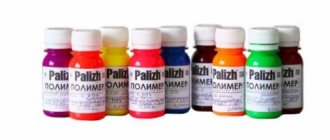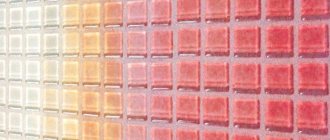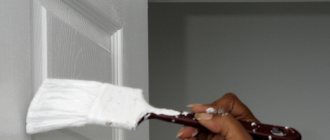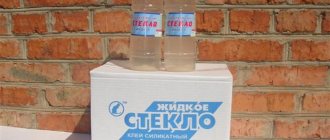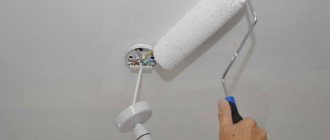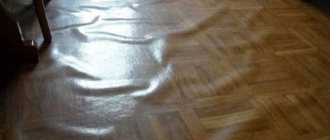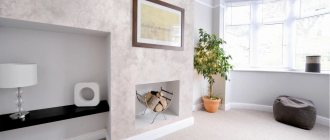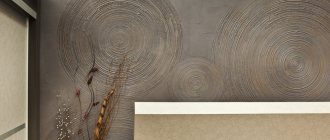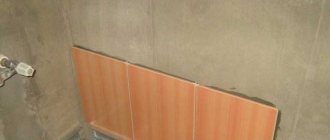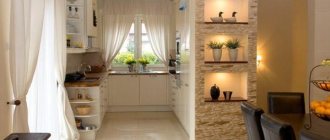To quickly and reliably protect any surfaces, paints are most often used. But if you want to preserve the natural, natural pattern, as well as the texture of the wooden surface, the use of epoxy transparent varnish is required.
This composition helps to effectively protect the material from negative influences, and will also emphasize the beauty of the wood texture.
Varnishes made on the basis of epoxy resin are used not only for wood, but also for concrete and other materials.
Paint options
Most often, the following paint and varnish materials are used for decorative products made on the basis of epoxy resin:
- Latex paint. Allows protection from the adverse effects of sunlight. The disadvantages of the coating include susceptibility to mechanical stress; scratches, chips and other minor defects appear on the surface very quickly.
- Alkyd compositions. They are easy to apply and do not emit toxic substances; they can be found on the shelf of any building effect. Expensive coatings allow you to protect a product made of epoxy resin for a long time, even with regular use.
- Polyurethane one-component compositions. They have more pronounced protective characteristics compared to alkyd ones, but they are more expensive; they often contain amines, which make the mixture unsuitable for working with epoxy.
- Polyurethane two-component compositions. Presented on the market with pigmented and colorless compounds, they guarantee a glossy surface, protect against the negative effects of ultraviolet rays, and provide increased wear resistance. They are dangerous to the human body; extreme care must be taken when working.
- Epoxy paints. They are presented on the market in one- and two-component compositions, their characteristics are similar to polyurethane coatings, they protect the finished product from mechanical and chemical influences, from ultraviolet rays, and provide wear resistance.
- Antifouling paints. The name brings together many coatings with different characteristics. In most cases, paint can be applied directly to the cured epoxy resin product; sometimes it may be necessary to pre-treat the surface with a primer.
Regardless of the type of coating chosen, before starting work, you should read the detailed instructions from the manufacturer. Before large-scale application, it is advisable to test the interaction of the paint coating with the epoxy resin on a small area.
Advantages and disadvantages
The advantages of such materials include:
- obtaining a dense transparent glossy film after painting;
- preserving and emphasizing the natural structure of wood;
- resistance to mechanical and chemical influences;
- abrasion resistance;
- ease of application and deep penetration into the pores of the base;
- minimum amount of drying time (2 hours);
- good adhesion to the surface;
- no smell.
- The mixture consists of toxic components. It is not allowed to work with such coating without protective equipment. Otherwise, burns to the mucous membranes of the eyes, respiratory tract, and skin are possible. A regular gauze respirator will not be enough to protect against toxic fumes. It is better to use masks for industrial purposes.
- This material collapses quickly. This leads to peeling of the layer previously applied to the surface. To prevent this from happening, the base is first prepared and primed.
- When varnish EP 2146 gets on plastic, it deforms its structure. Therefore, when working with it, it is recommended to use brushes and devices consisting of natural fibers.
- Painting is possible only with good ventilation of the room.
Surface preparation before applying varnish
Preparatory work includes cleaning the surface from:
- Wax residues;
- Fat;
- Oils;
- Old varnish;
- Various stains and dirt;
- Polishes;
- Other substances.
The surface to be treated must not only be clean, but also dry. For better adhesion of the varnish to the epoxy, it is advisable to treat the surface with a sanding attachment (do not forget to remove the resulting dust).
Glossy varnish Pebeo “GLOSS” for products made of epoxy resins
Examples of materials
The most popular type is epoxy-polyurethane varnish. It forms a coating that is resistant to corrosion and other negative environmental impacts. Withstands temperature changes from –200 to +120° C. Thanks to its components, it reliably insulates the surface from moisture, repels liquid and dirt. After complete drying, the layer is very durable and can withstand severe mechanical and electrical loads, as well as vibrations.
Elakor-ED is one example of varnishes that are intended exclusively for creating floor coverings. Easily applied to any prepared surface. It makes it possible to literally make floors durable, wear-resistant and completely sealed in just 1 day. Numerous studies have shown that such a varnished surface does not react with acids, alkalis and petroleum products. Therefore, you can use it not only in your own home, but also in production.
"Elakor-ED" is intended for pouring the last layers of epoxy coatings when solving the following problems:
- creating a 3D floor;
- decorating the floor covering with glitters and chips;
- obtaining a glossy finish;
- installation of chemical-resistant surfaces.
Application of a protective layer
The paint coating, which is applied over the decorative element, provides protection against mechanical damage (scratches, chips, abrasions, etc.) and interaction of the product with aggressive environments that can cause destruction of the material.
A properly selected protective coating can increase the overall service life of the finished epoxy resin product.
When choosing a varnish for epoxy resin, you should pay attention to the ability of the material to withstand ultraviolet rays. The sun directly affects the lifespan of the barrier layer; when it is destroyed, the product loses its original strength characteristics, changes color, and becomes unsuitable for further use.
It is better to give preference to white glossy or colorless varnishes. Such materials will allow you to preserve the product in its original form without loss of pigments for a maximum period, even with constant use.
Water-based polyurethane varnish Varatan, transparent gloss
Water-based polyurethane varnish for resin products
Popular brands
EP 2146
This parquet varnish is the leader in the list of domestically produced LKS from Yaroslavl Paints JSC.
Its advantages:
- It does not require primer.
- Peel-off drying time – 48 hours; between layers – 2 hours.
- Consumption – 1 kg per 1 sq. m.
- Gloss – 55% (semi-gloss).
- Type of material – one-component.
EP 730
This universal two-pack epoxy-based varnish is produced by Biokhim LLC from St. Petersburg. It is designed to protect metal and wood surfaces. This material is resistant to any type of influence: mechanical, chemical, alkaline, temperature.
Drying time – 1 hour.
Consumption – 80 g per square meter. m.
ET 3D
This composition is designed to create a 3D floor. It is applied to wood and concrete surfaces. The dense glossy fabric can withstand significant loads and is impervious to temperature changes.
Complete drying time – 48 hours.
Consumption – 1.5 kg per 1 sq. m.
Compatibility
Most paint and varnish coatings interact well with epoxy resin, creating a durable film on the surface that protects from chemical environments, adverse environmental factors, sunlight and mechanical damage.
If you are not 100% sure of the compatibility of epoxy with a particular varnish, you need to test coat a small area that you won’t mind disposing of if something goes wrong.
Remember that varnish should only be applied to fully cured epoxy resin. The hardening process may take about two weeks; to speed up, you can leave the product near the battery or place it in an oven at a minimum temperature for several hours.
You can speed up the hardening process by drying only on dark-colored products.
Where is epoxy used?
After varnishing with an epoxy composition containing ED-16 (or ED-20) resin, it will create a protective, reliable film.
This varnish is ideal for parquet, doors, windows, furniture and wood floors.
Since epoxy is a fairly durable material, it can safely be used to treat surfaces that “suffer” from frequent mechanical stress.
In addition, it is often used in the manufacture of souvenirs and putty.
Also used as a final coating for metal structures.
Recommendations from experts
When treating parquet, wood or concrete floors with varnish, you must adhere to the following simple recommendations:
- It is advisable to varnish in several layers; experts advise applying at least 3 layers. The number of coatings depends on how intensively the room is used, what loads the varnish will withstand, and what are the characteristics of the surface being treated;
- before applying the final varnish layer, it is advisable to lightly sand the surface;
- it is necessary to maintain the same consumption over the entire surface, about 120 grams per square meter. If the consumption is less, the varnished layer will not be strong enough, and if the consumption is much higher, the varnish will begin to wrinkle;
- It is important to carry out the varnishing process in a respirator that has a special insert that absorbs organic vapors. During the drying process, epoxy varnish emits vapors that are harmful and toxic to humans, from which it is necessary to protect the respiratory system.
By following these tips, the varnish coating will be strong and durable. Externally, it will look very attractive and shiny, and will reliably protect the treated base for many years.
The adhesive joint is destroyed
Possible reasons and tips
Short curing time
See previous question.
The seam is depleted of resin: the resin has been absorbed into the porous surface, creating voids in the seam.
Apply a layer of resin to the surfaces to be bonded, followed by resin and filler. Very porous and end surfaces should be coated twice.
The bonded surfaces are dirty.
The surfaces to be bonded must be clean and sanded. After processing with carpentry tools, the wood surfaces must be sanded.
The connection area is insufficient for workloads.
Increase the area by forming fillets, gluing fasteners and forming miter joints.
Excessive compression with clamps squeezed the resin out of the seam.
You need to compress the parts just enough so that the resin is slightly squeezed out of the joint.
The putty composition (resin + mixture 407 or 410) flows and does not sand well
Possible reasons and tips
The putty is not thick enough.
- Add more filler to the putty until it reaches the consistency of coconut oil. The more filler added, the thicker and easier it will be to sand.
- Before filling vertical surfaces, allow the bottom layer to cure.
Note by S.B. From examining the branded MSDS, it appears that “filler #407” consists of a mixture of phenolic microspheres, perlite and aerosil, and “filler #410” is “a mixture of thermoplastic and inorganic microspheres.”
